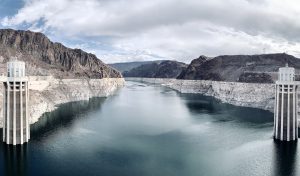
Certain provisions of the Inflation Reduction Act aim to alleviate intense drought conditions, exhibited by low water levels seen here in the “bathtub ring” around Lake Mead in Nevada and Arizona.
Post by Kathryn Obenshain, Project Analyst at the UNC Environmental Finance Center
The Inflation Reduction Act (IRA) became law on August 16, 2022 intending to limit the effects of inflation and lower the national deficit. The law is broad and includes provisions that focus on lowering healthcare and prescription costs, mitigating climate change, lowering energy costs, increasing corporate taxes, and improving public health. The climate change provisions of the IRA have been particularly celebrated, as Congress authorized $369 billion over the next ten years to put towards energy and climate issues, including drought and water security. CNBC reported that the law is “the most aggressive climate investment ever taken by Congress”, while the Bureau of Reclamation stated similarly that “The Inflation Reduction Act of 2022 is the most significant legislation in U.S. history to tackle the climate crisis and strengthen American energy security.” The exact impact of this landmark legislation on work done by the UNC EFC is uncertain, though environmental provisions of the IRA may include relevant information for local governments and other organizations seeking to improve their provision of environmental programs and services. These provisions have been summarized below.
Environmental provisions of the IRA aim to move the United States closer to its climate goals. Before the IRA, the US was on the trajectory to reduce emissions by 24-35% by 2030, driven by state and local policy measures. Now, US emissions will likely be reduced by 32-40% by 2030. The White House Office of Management and Budget (OMB) estimated that the climate provisions of the IRA as well as the resulting reduction in emissions could cut the social costs of climate change by $1.9 trillion by 2050. The OMB derived these social costs, which include property damage and negative public health impacts from data regarding temperature rise, sea level rise, health impacts of climate change, and natural disasters.
The water-related provisions of the IRA focused on mitigating the effects of drought and increasing the efficiency of water use. Congress allocated $4 billion for states in the western United States affected by drought, specifically “reclamation states” or states that are under the charge of the Bureau of Reclamation of the Department of the Interior. The Colorado River Basin and other areas in long-term drought are the priorities of the funding, with programs such as the Lower Colorado River Basin System Conservation and Efficiency Program aiming to use IRA funding to advance water efficiency and conservation.
A separate allocation of $550 million is dedicated to water supply projects in disadvantaged communities in reclamation states. These funds will be used for “grants, contracts, or financial assistance agreements for disadvantaged communities to pay for the cost of the planning, design, or construction of water projects in communities or households that do not have reliable access to domestic water supplies”. Separate funding is designated to enhance drought resiliency through the design and implementation for water conveyance facilities. Additional funds also address environmental justice issues by providing financial assistance to Native American tribes that have experienced water scarcity and lack of tribal resources due to previously implemented water projects in their region. The Department of Housing and Urban Development also received funding to improve affordable housing offerings, including improvements in water and energy efficiency and climate resiliency.
The IRA has a heavier focus on mitigating releases of emissions through the funding of energy efficiency programs and incentives and energy infrastructure. Congress directly targets energy infrastructure and decarbonization of the energy sector through tax credits, rebates, incentives, grants and loan programs that are funded to influence market and consumer behavior. These provisions aim to encourage electrification and increase energy efficiency at the household and community levels. For example, the High Efficiency Electric Home Rebate Program provides states with $4.5 billion in funding for state-level creation of rebate programs targeting low to medium income consumers. Incentives for contractor education in electrification and for the installation of energy efficient appliances in new homes are also included to support needed workforce development for the implementation of these property-level upgrades.
Additionally, Congress allocated $9.7 billion for rural electric cooperatives through the USDA so that electricity rural providers can reduce harmful emissions and transition to cleaner sources of electricity. Specifically, $5 billion is allocated to support $250 billion in loan guarantee authority, targeting formerly fossil fuel producing communities to stimulate their economies and invest in energy infrastructure. Federal loan guarantees are guarantees from the federal government that if the borrower defaults the lender will recoup their investments from the federal government. These are granted to encourage investment by borrowers that might otherwise have a hard time accessing capital. These investments are expected to have a large impact on employment—American Clean Power estimated that the IRA will create 500,000 new jobs and stimulate $600 billion in investment, while Energy Innovation estimated that 1.5 million jobs will be created.
The IRA is landmark climate legislation, but also provides needed funding to make changes in water and electricity sectors at the state and local level. This investment in infrastructure and the environment fits well into this recent era of increased federal infrastructure investment. To read more about recent infrastructure investment, read blogs from the UNC EFC on the Bipartisan Infrastructure Law and the American Rescue Plan Act.
Need technical assistance? The UNC Environmental Finance Center is here to help!
The Environmental Finance Center at UNC Chapel Hill offers free one-on-one technical assistance for small water systems. If you have an interest in our support, fill out our interest form here or contact efc@sog.unc.edu.
Visit https://efc.sog.unc.edu/technical-assistance/ to read more about technical assistance.

